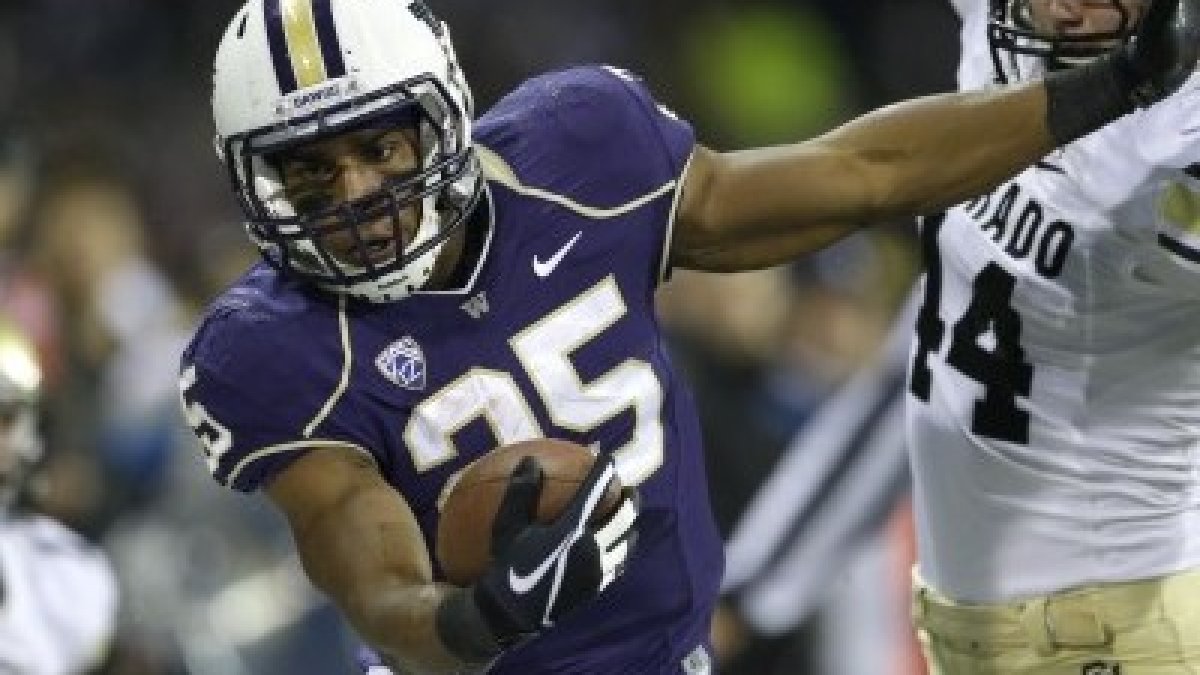 When the Titans selected Bishop Sankey in the second round, the hype train started rolling. Sankey was the first running back taken in the 2014 NFL Draft, and he fills a position of need in Tennessee.
When the Titans selected Bishop Sankey in the second round, the hype train started rolling. Sankey was the first running back taken in the 2014 NFL Draft, and he fills a position of need in Tennessee.
Looking at recent history, rookie running backs have a higher chance at fantasy success than wide receivers, tight ends, and quarterbacks. It wouldn’t be a surprise to see Sankey finish 2014 as the best rookie fantasy football player, and it’s reasonable to expect him to be at least an RB2 for your team.
It's true that just because a running back is a starter doesn’t mean he’s guaranteed to rack up fantasy points — just look at St. Louis’ Daryl Richardson for the proof. But Sankey is thought to have the skills required to shoulder the load from the get-go.
Chris Johnson’s name has been blackened because of his failure to recreate his 2009 success and for his perceived “show me the money” attitude. But keep in mind that Chris Johnson rushed for over 1,000 yards in each of his six seasons in Tennessee, including his rookie year.
Only five other players in NFL history have started their careers with at least six straight seasons with over 1,000 rushing yards, including Corey Dillon (6), Eric Dickerson (7), LaDainian Tomlinson (8), Barry Sanders (10), and Curtis Martin (10).
The point? Despite the ridicule Johnson has received, he has been effective, and at times dominant, as the Titans running back. Yes, he has been maddeningly inconsistent and likely should have had even better statistics, but when looked at in sum, there’s no denying Johnson put together respectable numbers during his tenure in Tennessee.
The above three paragraphs are basically one long way of saying that Sankey has landed in a favorable spot.
Shonn Greene is in Tennessee and will surely take some carries away from Sankey, but the rookie is lining up to be the main back in Music City. Additionally, Greene recently had knee surgery, per The Tennessean. While he is expected to be back for training camp in July, knee injuries are dicey for any running back.
So what can we expect from Sankey, assuming he takes the lead role? It’s fair to assume it will be a committee backfield with Greene and Dexter McCluster, but most NFL teams operate a backfield by committee, so that’s not a big deal.
Let’s say there are 380 carries to go around for all Tennessee running backs next season. That would be slightly above average for NFL teams (average was 372 last season) and just below what Tennessee managed last season (393).
Why predict that the Titans will run the ball slightly more than most teams? Last season, the Titans passed the ball 59 percent of the time, which led to them having the 22nd most pass-heavy approach in the league (also known at the 10th most run-heavy approach). When the Titans were behind last season, they passed the ball 65 percent of the time — 25th most in the league when playing from behind. Put simply: The Titans like to run the ball.
It’s true that those statistics could be meaningless moving forward, as the Titans will this season be coached by the more pass-thoughtful Ken Whisenhunt, but it gives you an idea of what the mindset in Tennessee has been.
Back to the theorizing: If the Titans have 380 carries to divvy up next season, and Sankey is the lead back, how many carries should we expect from him? I would expect Sankey to see no fewer than 200 carries. He may even see up to 250, depending on how Greene’s knee holds up, but the most reasonable expectation is about 225 carries.
I got that figure by assuming Sankey shoulders an average load for a team’s No. 1 running back — 59 percent of the carries. If Tennessee running backs carry the ball a combined 380 times, and Sankey totes it 59 percent of the time, that gives him 224.2 carries.
That’s not an unreasonable estimate by any means. 2013 rookies Zac Stacy (250) and Le’Veon Bell (244) each had more carries than that, and those two players only played 13 games. Eddie Lacy carried the ball 284 times as a rookie.
With 225 carries and a 4.0 YPC average — which would be below average — Sankey would eclipse 900 yards, leading me to believe a 1,000-yard season isn’t out of the picture.
Sankey also figures to be versatile in the passing game. Let’s say he’s a slight downgrade from Johnson in that department, who had 42 receptions for 348 yards and four touchdowns last season. We will give our hypothetical Sankey 35 receptions for 250 yards and two touchdowns.
If he puts up those receiving and rushing numbers and only scores five rushing touchdowns, he would still be a high-end RB3 or low-end RB2. And that’s with conservative figures.
In truth, Sankey's ceiling is higher — think high-end RB2.


 © 2025 PFF - all rights reserved.
© 2025 PFF - all rights reserved.